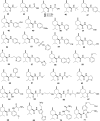Modulation of thermoreceptor TRPM8 by cooling compounds
- PMID: 22860192
- PMCID: PMC3369806
- DOI: 10.1021/cn300006u
Modulation of thermoreceptor TRPM8 by cooling compounds
Abstract
ThermoTRPs, a subset of the Transient Receptor Potential (TRP) family of cation channels, have been implicated in sensing temperature. TRPM8 and TRPA1 are both activated by cooling. TRPM8 is activated by innocuous cooling (<30 °C) and contributes to sensing unpleasant cold stimuli or mediating the effects of cold analgesia and is a receptor for menthol and icilin (mint-derived and synthetic cooling compounds, respectively). TRPA1 (Ankyrin family) is activated by noxious cold (<17 °C), icilin, and a variety of pungent compounds. Extensive amount of medicinal chemistry efforts have been published mainly in the form of patent literature on various classes of cooling compounds by various pharmaceutical companies; however, no prior comprehensive review has been published. When expressed in heterologous expression systems, such as Xenopus oocytes or mammalian cell lines, TRPM8 mediated currents are activated by a number of cooling compounds in addition to menthol and icilin. These include synthetic p-menthane carboxamides along with other class of compounds such as aliphatic/alicyclic alcohols/esters/amides, sulphones/sulphoxides/sulphonamides, heterocyclics, keto-enamines/lactams, and phosphine oxides. In the present review, the medicinal chemistry of various cooling compounds as activators of thermoTRPM8 channel will be discussed according to their chemical classes. The potential of these compounds to emerge as therapeutic agents is also discussed.
Keywords: TRPA1; TRPM8; Thermoreceptors; cooling compounds; icilin; menthol.
Figures
















Similar articles
-
Two different avian cold-sensitive sensory neurons: Transient receptor potential melastatin 8 (TRPM8)-dependent and -independent activation mechanisms.Neuropharmacology. 2016 Dec;111:130-141. doi: 10.1016/j.neuropharm.2016.08.039. Epub 2016 Aug 31. Neuropharmacology. 2016. PMID: 27590914
-
The roles of iPLA2, TRPM8 and TRPA1 in chemically induced cold hypersensitivity.Mol Pain. 2010 Jan 21;6:4. doi: 10.1186/1744-8069-6-4. Mol Pain. 2010. PMID: 20092626 Free PMC article.
-
Primary afferents with TRPM8 and TRPA1 profiles target distinct subpopulations of rat superficial dorsal horn neurones.Br J Pharmacol. 2009 Jun;157(3):371-80. doi: 10.1111/j.1476-5381.2009.00167.x. Epub 2009 Apr 3. Br J Pharmacol. 2009. PMID: 19371346 Free PMC article.
-
How cold is it? TRPM8 and TRPA1 in the molecular logic of cold sensation.Mol Pain. 2005 Apr 22;1:16. doi: 10.1186/1744-8069-1-16. Mol Pain. 2005. PMID: 15847696 Free PMC article. Review.
-
TRPM8, a sensor for mild cooling in mammalian sensory nerve endings.Curr Pharm Biotechnol. 2011 Jan 1;12(1):78-88. doi: 10.2174/138920111793937835. Curr Pharm Biotechnol. 2011. PMID: 20932256 Review.
Cited by
-
Structural and in Vitro Functional Characterization of a Menthyl TRPM8 Antagonist Indicates Species-Dependent Regulation.ACS Med Chem Lett. 2021 Mar 31;12(5):758-767. doi: 10.1021/acsmedchemlett.1c00001. eCollection 2021 May 13. ACS Med Chem Lett. 2021. PMID: 34055223 Free PMC article.
-
Antipruritic effect of cold stimulation at the Quchi acupoint (LI11) in mice.BMC Complement Altern Med. 2014 Sep 19;14:341. doi: 10.1186/1472-6882-14-341. BMC Complement Altern Med. 2014. PMID: 25239797 Free PMC article.
-
Identification of a Novel TRPM8 Agonist from Nutmeg: A Promising Cooling Compound.ACS Med Chem Lett. 2017 May 31;8(7):715-719. doi: 10.1021/acsmedchemlett.7b00104. eCollection 2017 Jul 13. ACS Med Chem Lett. 2017. PMID: 28740604 Free PMC article.
-
TRPM Channels in Human Diseases.Cells. 2020 Dec 4;9(12):2604. doi: 10.3390/cells9122604. Cells. 2020. PMID: 33291725 Free PMC article. Review.
-
The combination of TRPM8 and TRPA1 expression causes an invasive phenotype in lung cancer.Tumour Biol. 2014 Feb;35(2):1251-61. doi: 10.1007/s13277-013-1167-3. Epub 2013 Sep 15. Tumour Biol. 2014. PMID: 24037916
References
-
- Green B. G. (2004) Temperature perception and nociception. J.Neurobiol. 61, 13–29. - PubMed
-
- Lumpkin E. A.; Caterina M. J. (2007) Mechanisms of sensory transduction. Nature 445, 858–865. - PubMed
-
- Levine J. D.; Alessandri-Haber N. (2007) TRP channels: Targets for the relief of pain. Biochim. Biophys. Acta 1772, 989–1003. - PubMed
-
- Tominaga M.; Caterina M. J. (2004) Thermosensation and pain. Inc. J. Neurobiol. 61, 3–12. - PubMed
-
- Dhaka A.; Viswanath V.; Patapoutian A. (2006) TRP ion channels and temperature sensation. Annu. Rev. Neurosci. 29, 135–161. - PubMed
Publication types
MeSH terms
Substances
LinkOut - more resources
Full Text Sources
Other Literature Sources

